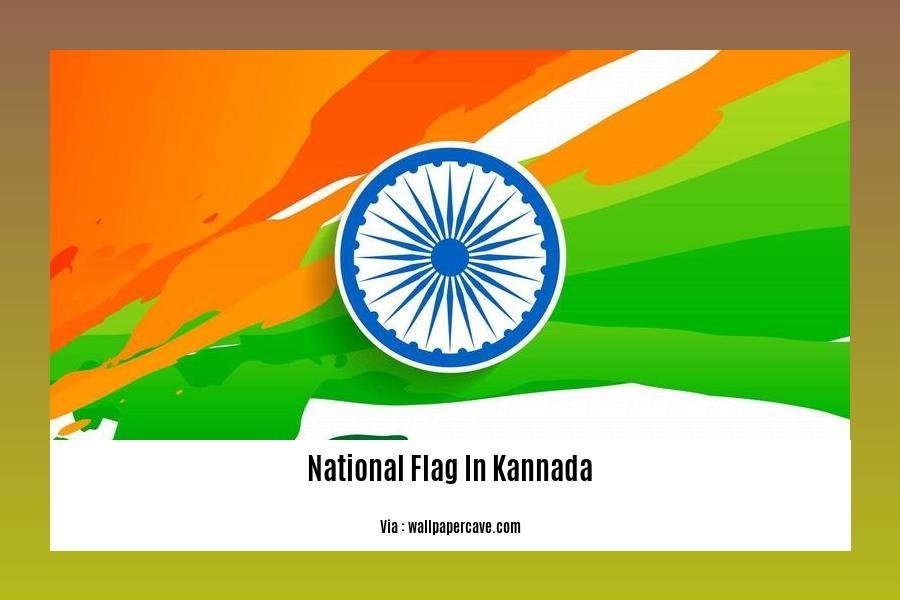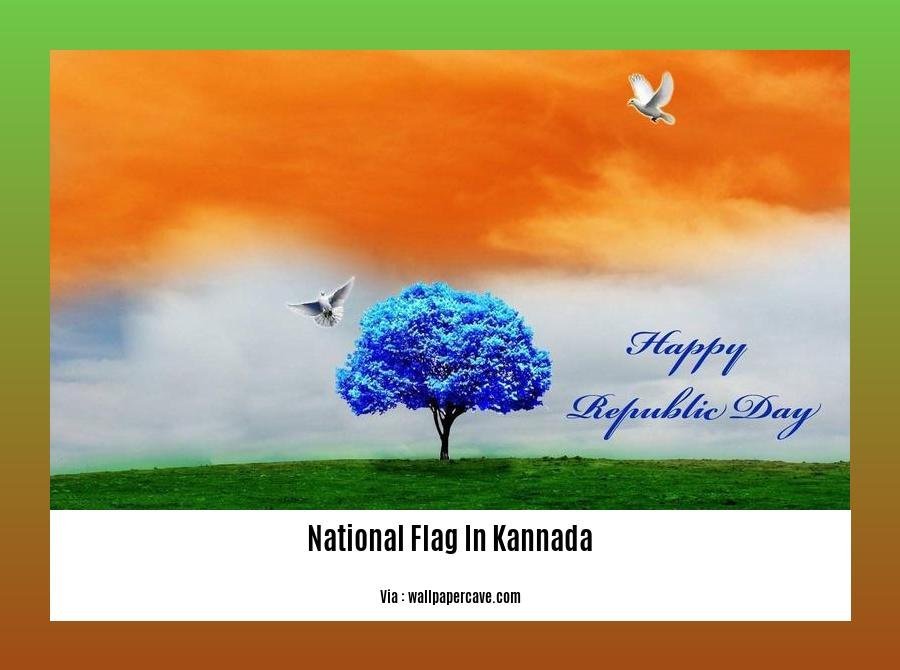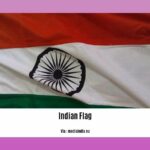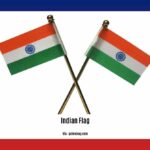The Kannada National Flag holds a rich cultural significance for the people of Karnataka, serving as a powerful symbol of their heritage and identity. Known as the “Kannada Rashtra Dhwaja” in the local language, this flag represents the vibrant traditions and values of the Kannada community. In this article, we will delve into the profound meaning behind the Kannada National Flag, uncovering its historical significance and exploring the captivating beauty embodied within its design.
Key Takeaways:
- The national flag of India represents courage, sacrifice, and the greater good of the nation.
- It consists of three colors – saffron, white, and green – along with the Ashoka Chakra in the center.
- Saffron symbolizes courage and sacrifice, white represents purity and truth, and green signifies fertility, prosperity, and harmony.
- The Ashoka Chakra with 24 spokes symbolizes progress, righteousness, and the continuous movement of life.
- The national flag is made of pure khadi, reflecting the principles of self-reliance and self-sufficiency.
- There are protocols and guidelines for displaying and handling the flag, including respectful hoisting and never using it for disrespectful purposes.
- The national anthem, “Jana Gana Mana,” should be sung after hoisting the flag.
- The national flag serves as a unifying symbol, representing the diversity and unity of the nation and reminding us of our duties and responsibilities.
Exploring the Significance and Beauty of the Kannada National Flag

The national flag of India, known as the ಕನ್ನಡ ರಾಷ್ಟ್ರ ಧ್ವಜ (Kannada Rashtra Dhwaja), is a powerful symbol that represents the spirit, unity, and identity of the nation. Let us delve into the extraordinary meaning behind the colors and symbols of this revered flag.
Colors that Speak Volumes
The ಕನ್ನಡ ರಾಷ್ಟ್ರ ಧ್ವಜ is a tricolor flag, comprised of saffron, white, and green colors. Each color holds profound symbolism that signifies the core values and aspirations of India.
Saffron: This vibrant hue stands as a testament to the bravery and sacrifice of our freedom fighters. It embodies the indomitable spirit of the nation, representing courage and strength.
White: The color white reflects purity and truth. It embodies the path of righteousness and peace that our great nation aspires to follow.
Green: Symbolizing fertility, prosperity, and harmony, the color green represents the importance of sustainable development and a prosperous future for our nation.
The Timeless Ashoka Chakra
At the center of the ಕನ್ನಡ ರಾಷ್ಟ್ರ ಧ್ವಜ lies the Ashoka Chakra, a wheel with 24 spokes. Derived from the Wheel of Law or Dharma, this significant emblem represents progress, righteousness, and the continuous movement of life.
A Tribute to Swadeshi Movement
The mighty Kannada national flag is made of pure khadi, a fabric spun and woven by hand. By utilizing khadi, the flag commemorates the Swadeshi movement, emphasizing the principles of self-reliance and self-sufficiency.
Protocols and Guidelines
The ಕನ್ನಡ ರಾಷ್ಟ್ರ ಧ್ವಜ demands utmost respect and adherence to protocols when displayed or handled. Here are a few key guidelines:
- The flag should always be hoisted or displayed respectfully, with the saffron color on top.
- It must never touch the ground or be used for any disrespectful or commercial purposes.
- After hoisting the flag, it is customary to sing the national anthem, “Jana Gana Mana,” as a mark of respect and patriotism.
Symbol of Unity and Sacrifice
The Kannada national flag serves as a unifying symbol, representing the diverse yet united fabric of our nation. It reminds us of the sacrifices made by our freedom fighters and instills a sense of duty and responsibility towards our beloved country.
In conclusion, the ಕನ್ನಡ ರಾಷ್ಟ್ರ ಧ್ವಜ holds immense significance and beauty. Its colors and symbols encapsulate the noble ideals and aspirations of our great nation, inspiring generations to come.
Sources:
1. Careerindia – National Flag
2. Kannada Deevige – National Flag Essay in Kannada
Here are some interesting facts about the Indian flag for Class 1 students! Learn more about the Indian flag and its significance in our article on few lines on Indian flag for class 1.
Do you want to know more about the national flag? Check out our article on few lines on national flag for class 1, where we explore interesting details about the national flag!
Discover fascinating details about the Indian flag in just a few sentences! Head over to our article on few sentences about Indian flag for a quick read.
Looking for information about the national flag? Read our article on five sentences about national flag to learn interesting facts about this patriotic symbol of our country.
Rashtra Dhwaja Prabandha in Kannada

The national flag, or “Rashtra Dhwaja,” holds a special place in the hearts of every citizen of Karnataka. It is not just a piece of cloth; it is a symbol of pride, unity, and freedom. In this article, we will explore the significance and beauty of the Kannada national flag.
Symbolizing Independence and Unity
The Kannada national flag is a representation of our rich cultural heritage and the spirit of unity among the people of Karnataka. Just like the Indian national flag, it is a tricolor flag, consisting of saffron, white, and green.
Saffron: Courage and Sacrifice
The saffron color in the flag symbolizes courage, sacrifice, and selflessness. It reminds us of the brave freedom fighters who fought for our independence and sacrificed their lives in the process. This color represents the indomitable spirit of Karnataka and its people.
White: Purity and Truth
The white color in the flag represents purity, truth, and peace. It signifies the path of righteousness and the commitment of the people of Karnataka to uphold moral values and principles. The white color also stands for the peaceful coexistence of different communities and the harmonious nature of our society.
Green: Growth and Prosperity
The green color in the flag symbolizes growth, fertility, and prosperity. It represents the agricultural wealth of Karnataka and the importance of sustainable development. Like the green fields that bring nourishment and abundance, this color reminds us of the need to protect our environment and work towards a prosperous future.
The Emblem of Karnataka
In the center of the Kannada national flag, we find the emblem of Karnataka. This emblem is a depiction of the state’s coat of arms, which consists of two Gandaberunda birds facing each other. The Gandaberunda is a mythical bird in Hindu mythology, known for its immense strength. It symbolizes power, courage, and victory. The emblem serves as a reminder of the glorious history and cultural heritage of our state.
Respecting the Kannada National Flag
As responsible citizens, it is our duty to honor and respect the Kannada national flag. When hoisting the flag, it should be done in a correct and dignified manner. It should never touch the ground or be used for any disrespectful purposes.
Key Takeaways:
- The Kannada national flag represents the unity and freedom of the people of Karnataka.
- Saffron symbolizes courage and sacrifice, white represents purity and truth, and green signifies growth and prosperity.
- The emblem of Karnataka, featuring Gandaberunda birds, represents power and victory.
- We must treat the Kannada national flag with utmost respect and adhere to proper protocols when hoisting and handling it.
Sources:
– Kannada New – National Flag Essay in Kannada
– Spardhavani – Indian Flag in Kannada
National Flag In Kannada Essay
The national flag holds immense importance in any country, and India is no exception. It represents the sovereignty, pride, and unity of the nation. The Indian national flag is commonly known as the “Tiranga,” which means tricolor in English.
The Indian national flag is designed with three horizontal stripes of saffron (kesari), white, and green, from top to bottom. These colors symbolize different aspects of the country.
The saffron color in the flag represents courage, sacrifice, and renunciation. It signifies the strength and spirit of the Indian people.
The white color represents truth, peace, and purity. It symbolizes the honest and peaceful nature of the country.
The green color represents fertility, growth, and auspiciousness. It symbolizes the agricultural richness and prosperity of India.
The flag also features a navy blue Ashoka Chakra in the center of the white stripe. This Chakra has 24 spokes and represents the eternal wheel of law.
The national flag was designed by Pingali Venkayya and was adopted by the Constituent Assembly of India on 22nd July 1947.
The national flag is not only a symbol of national identity but also holds significance in various aspects of the country.
Cultural Significance: The national flag reflects the rich cultural heritage and diversity of India. It represents the unity of different states and communities that reside within the country.
Patriotic Symbol: The national flag instills a sense of patriotism and pride among the citizens of India. It evokes loyalty and love for the nation.
Independence and Freedom: The hoisting of the national flag on Independence Day (15th August) and Republic Day (26th January) commemorates the freedom struggle and the establishment of a democratic nation.
International Representation: The Indian national flag serves as a symbol of recognition and identity for the country in international arenas, such as sports events, diplomatic meetings, and global forums.
Honoring National Heroes: The national flag is used to pay homage to national heroes, such as soldiers, freedom fighters, and martyrs, who sacrificed their lives for the nation’s welfare.
Educational Purpose: The national flag is an educational tool that teaches children about the values, history, and culture of India.
Protection and Preservation: The flag represents the honor and sanctity of the nation. It is protected under the Flag Code of India, which specifies guidelines for its proper display, handling, and disposal.
It is essential to handle the national flag with utmost respect and dignity. The Flag Code of India outlines specific rules and regulations to ensure the appropriate usage of the flag.
In conclusion, the Indian national flag is a symbol of pride, unity, and sovereignty. Its tricolor design and symbolic colors represent the diverse aspects of the country. The flag holds immense cultural, patriotic, and historical significance and serves as a reminder of the sacrifices made by the freedom fighters. As responsible citizens, it is our duty to honor and respect the national flag in every possible way.
Key Takeaways:
- The Indian national flag features three colors: saffron, white, and green, along with the Ashoka Chakra in the center.
- The colors symbolize courage, sacrifice, truth, peace, fertility, growth, and prosperity.
- The flag represents cultural diversity, patriotism, and the struggle for independence.
- It serves as a recognition symbol internationally and honors national heroes.
- The national flag is also an educational tool and is protected under the Flag Code of India.
Sources:
- kannadadeevige.in – National Flag Essay in Kannada
- kannadadeevige.in – Rashtra Dhwaja Prabandha in Kannada
FAQ
Q1: What is the meaning of the saffron color in the Kannada national flag?
A1: The saffron color in the Kannada national flag represents courage, sacrifice, and selflessness. It signifies the strength and spirit of the Indian people.
Q2: What does the white color symbolize in the Kannada national flag?
A2: The white color in the Kannada national flag represents truth, peace, and purity. It symbolizes the honest and peaceful nature of the country.
Q3: What does the green color signify in the Kannada national flag?
A3: The green color in the Kannada national flag signifies fertility, growth, and auspiciousness. It symbolizes the agricultural richness and prosperity of India.
Q4: What is the significance of the Ashoka Chakra in the Kannada national flag?
A4: The Ashoka Chakra in the Kannada national flag represents the eternal wheel of law. It has 24 spokes and symbolizes progress, righteousness, and the continuous movement of life.
Q5: What is the material used to make the Kannada national flag?
A5: The Kannada national flag is made of pure khadi, a hand-spun and hand-woven fabric. It is a tribute to the Swadeshi movement and reflects the principles of self-reliance and self-sufficiency.
- Discover Long Black Pepper: Flavor & Health Benefits - April 25, 2025
- Shocking Twists: The Grownup Review: Unreliable Narration - April 25, 2025
- A Quiet Place Book vs Movie: A Deep Dive - April 25, 2025
















